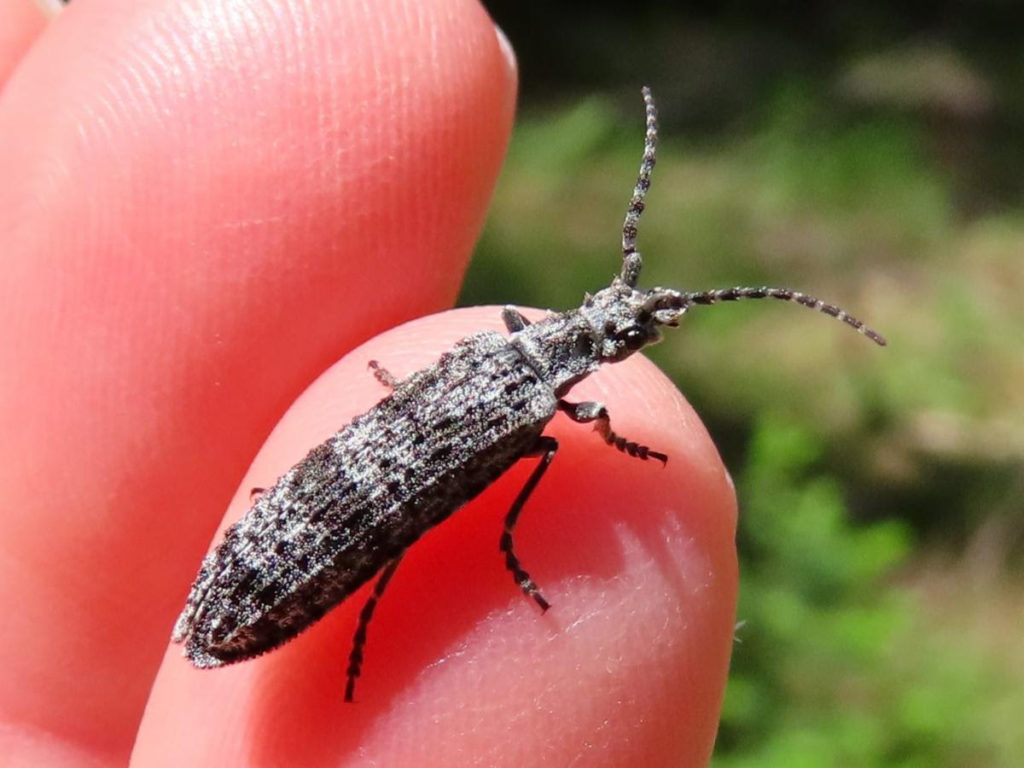The insects are officially out in full force; rain or shine, you’re likely to find something just by stepping out your front door. We’re seeing tons of butterflies and moths, and even the first signs of dragonflies. With summer just around the corner, activity is turned up to 11; insects aren’t just buzzin’, they’re chirping, hopping, droning, and whizzing by your face so fast they’re sometimes just a blur.
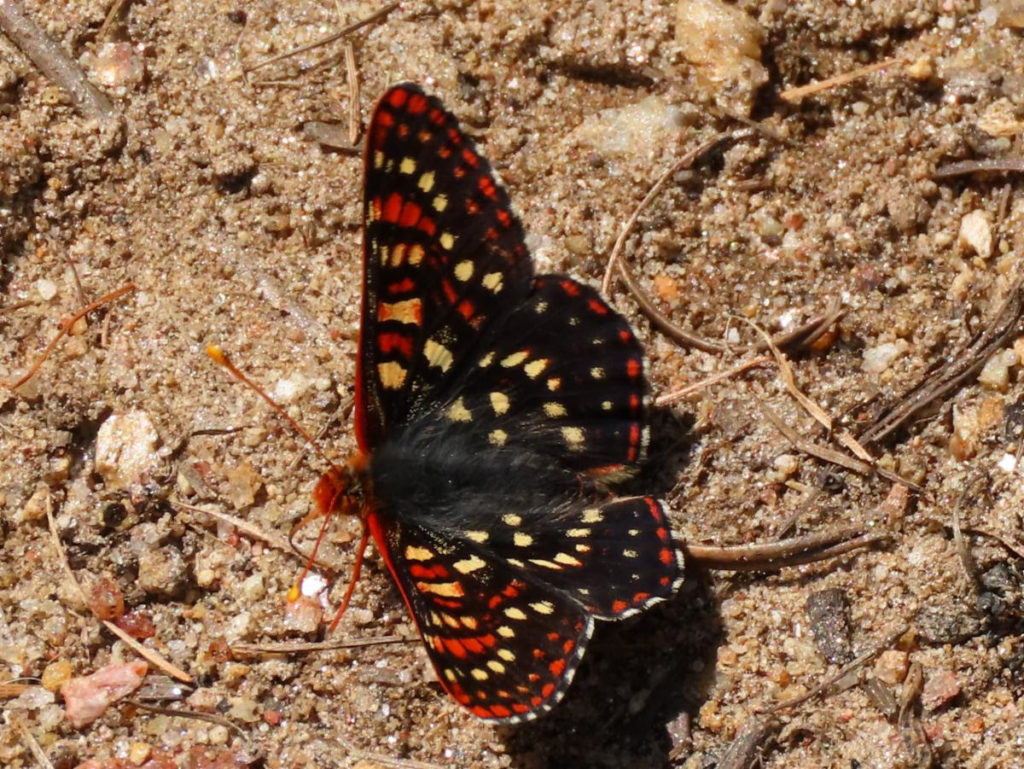
Snowberry Checkerspot
Euphydryas colon
This checkerspot is so named for it’s larval food source, the snowberry. However, whether or not this species is its own or a subspecies of the variable checkerspot, Euphydryas chalcedona, is up for debate. Some argue that all E. chalcedona north of California should be considered E. colon, but evidence to support these two as separate species is lacking. This species (or subspecies) has a northwestern distribution, from the northern tip of CA into British Columbia, and as far east as Western MT.
Kelly Dix, May 21st, 2023. Bass Creek, Florence, MT
Boreal Long-Lipped Tiger Beetle
Cicindela longilabris
Tiger beetles are fast, flighty, and voracious predators. Their humongous, bulging eyes provide unparalleled eyesight, allowing them to track and chase down their prey while their long legs give them a major speed boost. Tiger beetles run so fast, their brain cannot process what their eyes are seeing. In other words, they can literally run themselves blind. Every once in a while, they may stop and reorient themselves to pinpoint their prey. These beetles are often found in open sandy areas or running down forest roads and trails.
Glenn Marangelo, May 20th, 2023. Missoula, MT.

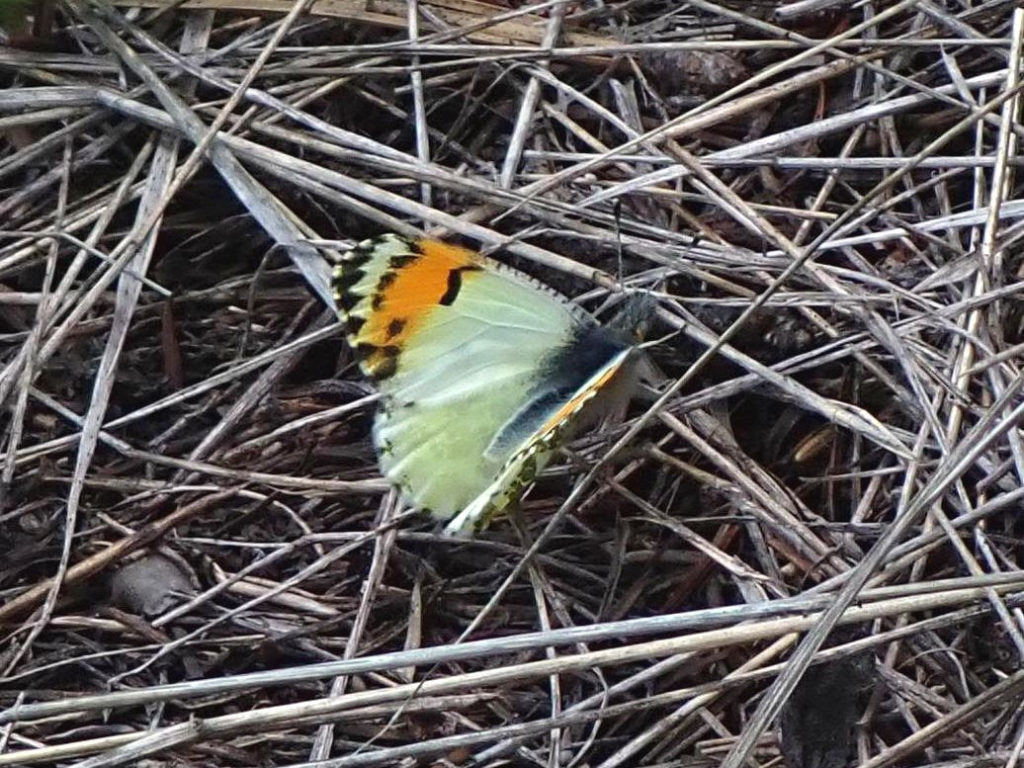
Julia Orangetip
Anthocharis julia
Move over Sara! Up until a few years ago, this beautiful butterfly was typically referred to as the Sara Orangetip (and still is according to just about every butterfly guide). But this formerly considered subspecies of the Sara Orangetip has been broken out as its own species and is what we find here in Montana …so that’s the name we’re using here. They are typically found from late April into late June in western Montana. The larval food plants are various native and exotic mustards.
Judy Halm, May 28th, 2023. Helena, MT
Rocky Mountain Clearwing
Hemaris thetis
These beautiful day-active moths can certainly make you think you are seeing a bumblebee or even a small hummingbird. They typically hover above flowers while feeding, much like a hummingbird. They emerge from the cocoon with scales fully covering their wings. However, their rapid wing beats quickly cause the scales to fall off, revealing the moth’s namesake clear wings. Larvae feed on leaves of snowberry and honeysuckles.
Brenna Shea, May 29th, 2023. Upper Rattlesnake, Missoula, MT


Flower Longhorn Beetle
Evodinus monticola vancouveri
The Vancouver Flower Longhorn Beetle is another species who species/subspecies status is debated amongst taxonomists. Some sites list this species as simply E. vancouveri, while others list it as a subspecies of E. monticola. Based on the ranges of E. monticola and E. monticola vancouveri, we believe this individual to be the latter. Adults can be seen from May to July; their larvae develop in conifer forests.
Kelly Dix, May 27th, 2023. Ross Creek Cedars, Kootenai National Forest, MT
White Dotted Prominent
Nadata gibbosa
Aptly named, White-dotted Prominents have a pair of white dots at the end of a kidney-shaped spot on their smooth yellow and tan forewings. They are common and widely distributed in hardwood forests and riparian zones throughout North America, where the larvae feed on a wide variety of broad-leaved trees and shrubs. The nocturnal adults do not feed, but will readily come to lights. Once drawn in, they usually sit lethargically in one spot.
Lisa Ann Cloo, May 31st, 2023. Missoula, MT

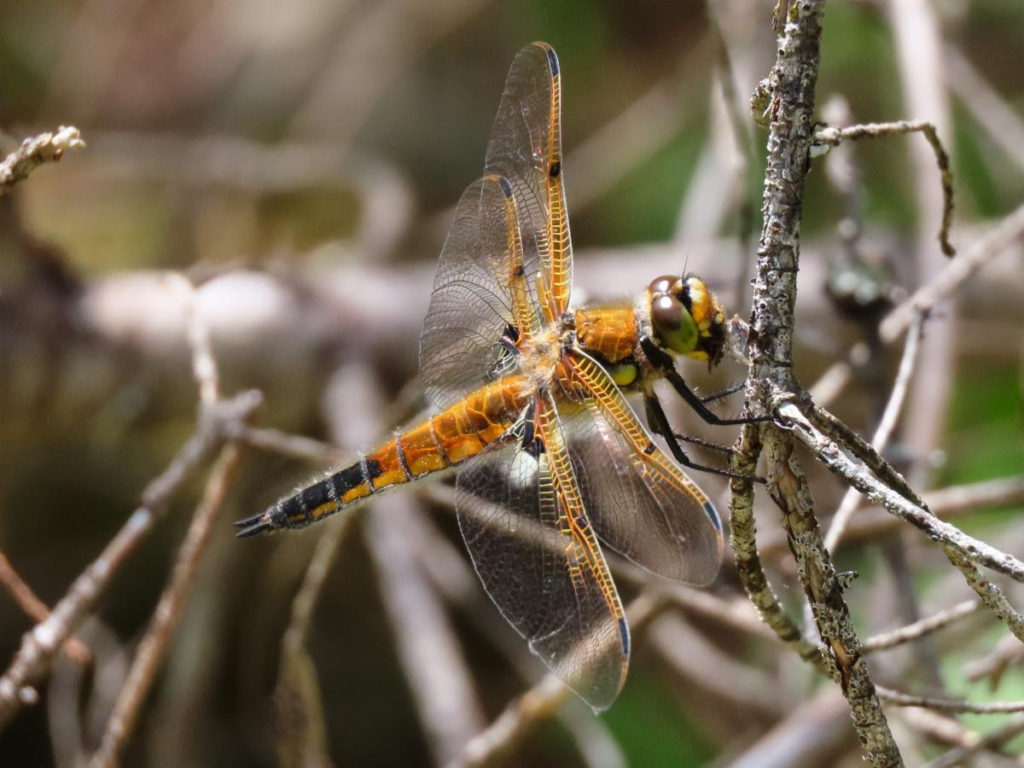
Four Spotted Skimmer
Libellula quadrimaculata
Across the pond, these large, early dragonflies are called Four-spotted Chasers and “Described as looking like a ‘flying cigar’ due to their uniform and chunky appearance” (British Dragonfly Society). These “flying cigars” are circumboreal and can be observed across North America, from Arizona and New Mexico in the south to Alaska and the Yukon to the north, throughout Europe and northwestern Africa to Asia and Japan.
Kelly Dix, May 27th, 2023. Ross Creek Cedars, Kootenai National Forest, MT
Nelson’s Cedar Hairstreak
Callophrys gryneus nelsoni
While this sighting is likely on the very edge of this species’ range (west from Sierra Nevada, into southwestern Oregon as well with sighting in Washington and British Columbia), we believe this to be a Nelson’s Cedar Hairstreak given that it was found in a unique cedar habitat not commonly found in Montana. The larvae of this subspecies primarily feed on Western Red Cedar; adults take wing from April-June in the northern part of their range.
Kelly Dix, May 27th, 2023. Ross Creek Cedars, Kootenai National Forest, MT
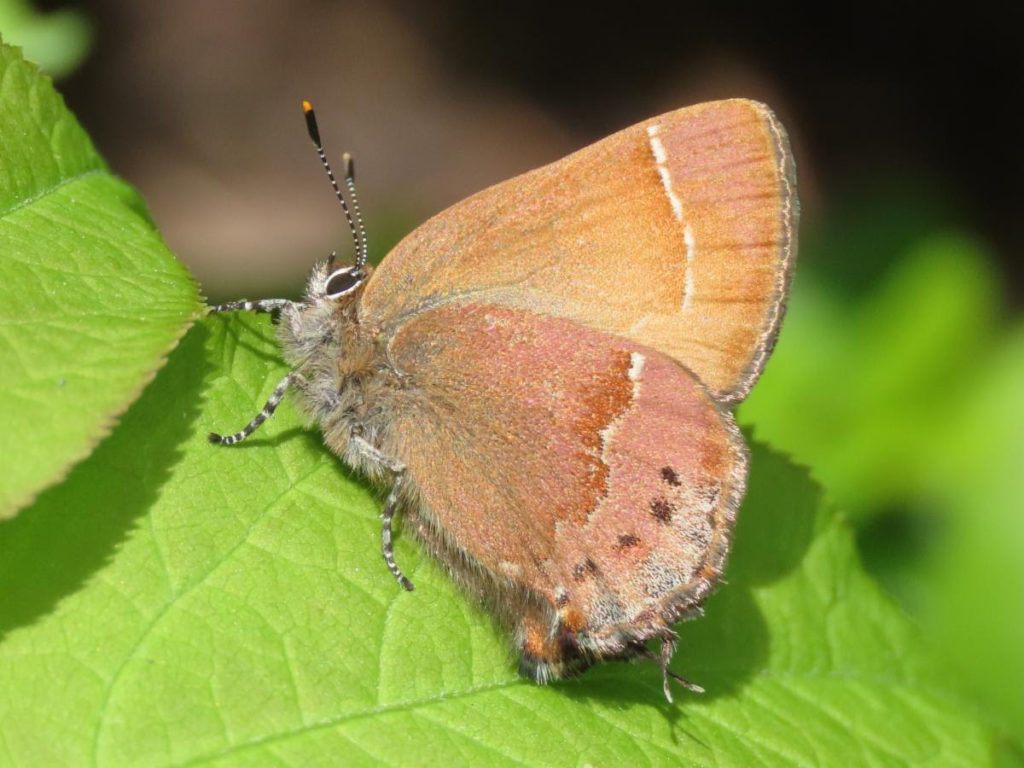

Lilac Root Weevil
Otiorhynchus meridionalis
Don’t be fooled by the signs of these weevils like Bug Wrangler Brenna was. “I found these near-perfect circles cut out of the edges of the leaves of a lilac near my house,” she says. “I was so excited at first, thinking I had leafcutter bees nearby.” Lilac root weevils indeed leave similiarly shaped cut-outs on leaf margins – but to a much greater extent than leafcutter bees. You may find an entire lilac plant with serrated leaf edges thanks to these miniscule weevils. Luckily, they only consume the edges, leaving the rest of the leaf in tact, and the plant relatively unharmed. Picky eaters.
Glenn Marangelo, May 27th, 2023. Missoula, MT
Rose Stem Girdler
Agrilus cuprescens
As a member of the Buprestidae (metallic wood-boring beetles), A. cuprescens has a reputation for causing damage to woody plant stems. Given the common name, this species preferred larval plant host is somewhat obvious, but will also use raspberry, currant and gooseberry. This species is considered adventive in North America; despite being widespread, it may not be permanently established. A cuprescens is native to, and widespread in the Palaearctic, and now widespread east of the Rockies.
Glenn Marangelo, May 27th, 2023. Missoula, MT


Western Lynx Spider
Oxyopes scalaris
Similar to wolf spiders and jumping spiders, western lynx spiders are active hunters that are fast runners and leapers with good vision. Rather than hunting on the ground, they are referred to as “foliage hunters” — often lying in wait to capture prey on plants, trees, and bushes. Their long, spiny bristles form a “basket-like” cage that may assist in capturing prey and providing the spider with some protection.
Corinne Williams, May 26th, 2023. Missoula, MT
Pale Swallowtail
Papilio eurymedon
Pale swallowtails are recognized by their cream-colored or pale yellow wings, unlike most other swallowtails that are known for their bright yellow and black patterning. Large congregations of males can be seen “puddling,” seeking nutrients and minerals in damp spots on the ground. Adults take wing from April – July; their offspring emerge and grow into plump green caterpillars, before overwintering in their pupal stage. This species can be found across western North America, from British Columbia south to southern California, east to Montana, and in mountains south to New Mexico.
Trudy, May 22nd, 2023. Elmo, MT

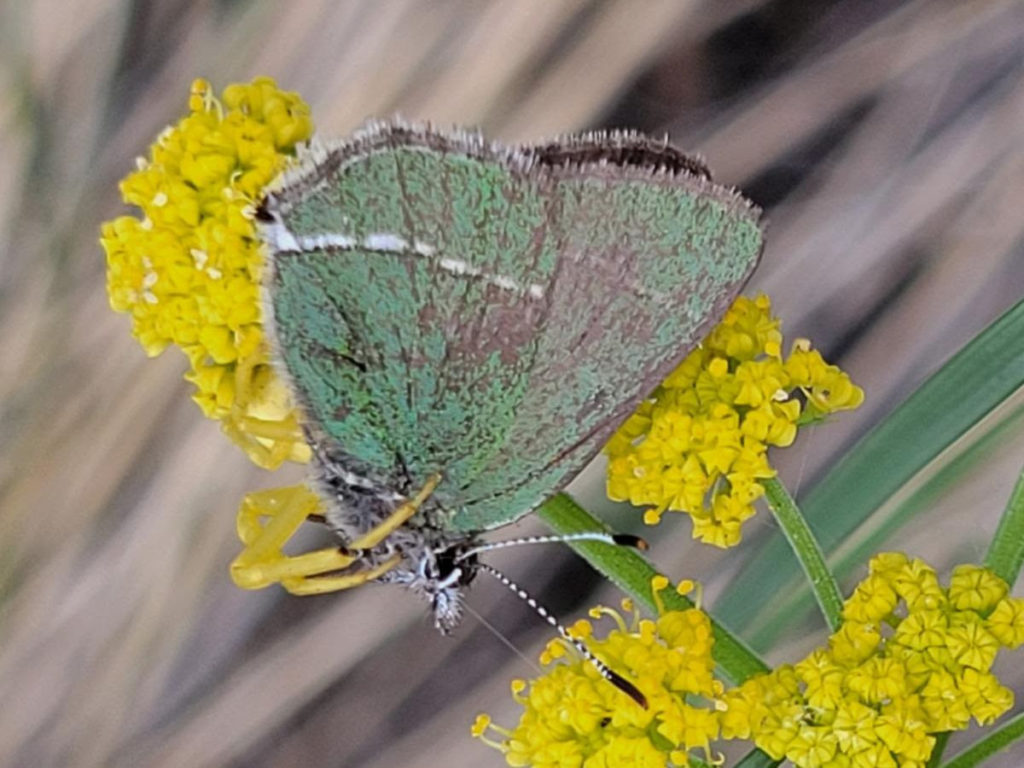
Sheridan’s Hairstreak
Callophrys sheridanii
When Connie sent us this photo of a Sheridan’s hairstreak, she said, “I was excited to see this hairstreak, until I realized it was being eaten by a flower/crab spider.” It’s tough to spot, but you can just make out some cryptic yellow legs wrapping around the butterfly. Callophrys sheridanii can be found in dry, open habitats at relatively high elevations (up to 10,000 feet). This species is found in North America along the south coast of British Columbia and parts of Nevada, Arizona, Saskatchewan, North Dakota, and New Mexico. In 2009, it was officially recognized as the state butterfly of Wyoming.
Connie Geiger, May 30th, 2023. Helena, MT
Priacma Bleach Beetle
Priacma serrata
The Priacma Bleach Beetle is the only living member of the genus Priacma. As a member of the family Cupedidae (reticulated beetles), they have the characteristic pattern of small square “windows” on their elytra. But you may be wondering where the name “bleach beetle” comes from. Males of this species are strongly attracted to the scent of bleach, suggesting that bleach contains chemical components similiar to the pheromones given off by females. This species is found largely in the Pacific Northwest; from British Columbia to central California, and as far east as western Montana.
Kelly Dix, May 27th, 2023. Ross Creek Cedars, Kootenai National Forest, MT
